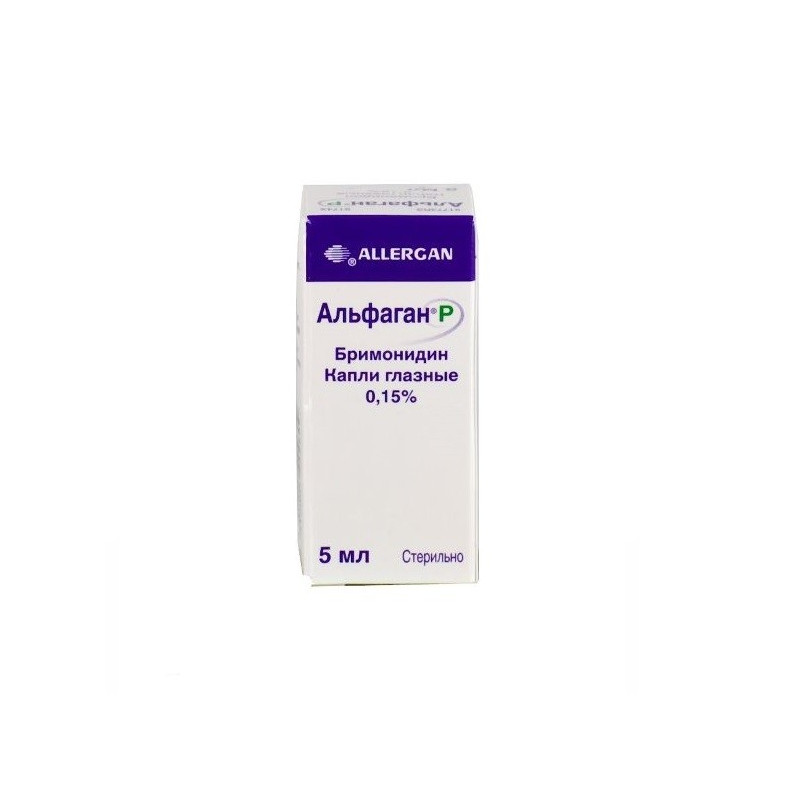



 All payments are encrypted via SSL
All payments are encrypted via SSL
 Full Refund if you haven't received your order
Full Refund if you haven't received your order
Eye drops
1 ml. contains brimonidine tartrate 1.5 mg;
auxiliary components: hydroxy-chloro complex stabilized (sodium chloride, sodium chlorate, chlorine dioxide), sodium carmellose, sodium chloride, potassium chloride, Calcium chloride dihydrate, Magnesium chloride hexahydrate, boric acid, sodium tetraborate decahydrate, hydrochloric acid or sodium hydroxide, purified water.
Bottle of 5 ml.
Brimonidine is a selective α2-adrenomimetic that has a stimulating effect on α2-adrenergic receptors. When used in the form of eye drops 1.5 mg / ml, the maximum effect of reducing intraocular pressure (IOP) is achieved after 2 hours. The hypotensive effect of brimonidine is achieved by reducing the formation and increasing the outflow of intraocular fluid along the uveoscleral tract.
Open-angle glaucoma. Increased eye pressure (both monotherapy and in combination with other drugs that reduce IOP).
Hypersensitivity to brimonidine tartrate and other components Alphagan R. Simultaneous therapy with MAO inhibitors. During pregnancy and breastfeeding.Children's age up to 2 years, low body weight (up to 20 kg), since the safety and efficacy of the drug in these groups of patients has not been studied.
Alphagan P is used topically. Instill into the conjunctival sac of the affected eye 1 drop 3 times a day with an interval between administrations of 8 hours. Alphagan P can be used with other ophthalmologic drugs to reduce IOP. If the patient simultaneously uses other eye drops, it is necessary to adhere to an interval of at least 5 minutes between instillations.
The frequency of side effects identified during the studies was assessed as follows: very often (and> 10%); Often (and> 1% and and 0.1% and and 0.01% and and In the clinical studies of the drug Alphagan P revealed the following side effects:
From the organs of vision: very often - allergic conjunctivitis, hyperemia of the conjunctiva of the eyes, itching of the mucous membrane of the eyes and the skin of the eyelids; ancillary units, occlusion of the conjunctiva of the eye and follicular conjunctivitis, local eyebrows eye, dryness and irritation of the mucous membrane of the eyes, pain, swelling of the eyelids, redness of the eyelids, foreign body sensation in the eyes, keratitis, damage to the eyelids,photosensitivity, superficial spotted keratopathy, lacrimation, loss of visual field, functional damage to the vitreous body, vitreous hemorrhage, floating opacities in the vitreous body and reduced visual acuity; infrequently - erosion of the cornea, barley.
From the side of the central nervous system: often - headache, drowsiness, insomnia, dizziness.
Cardiovascular: often - increased blood pressure; infrequently - decrease in blood pressure.
Respiratory: often - bronchitis, cough, shortness of breath; infrequently - dry nasal mucosa, apnea.
From the digestive tract: often - gastrointestinal disorders, dyspepsia, dryness of the oral mucosa.
On the part of the skin and subcutaneous fat: often - rash, infectious disease (chills and respiratory infection), rhinitis, sinusitis, including infectious.
Laboratory values: often - hypercholesterolemia.
Others: often - common allergic reactions, asthenia, fatigue; Infrequently - a change in taste.
In children it is noted: apnea, bradycardia, lowering blood pressure, hypothermia, hypotension.
Additionally obtained data on the following effects:
From the organs of vision: frequency is unknown - iritis, keratoconjunctivitis, miosis.
From the side of the central nervous system: depression.
Cardiovascular: bradycardia, tachycardia.
From the digestive tract: nausea.
On the part of the skin and subcutaneous fat: local skin reactions (erythema, pruritus, swelling of the face, rash and vasodilation of the eyelid skin vessels).
Despite the evidence of the insignificant effect of brimonidine tartrate on total blood pressure, it is necessary to use it with caution in patients with the following diseases: orthostatic hypotension, severe cardiovascular diseases accompanied by heart failure, cerebrovascular diseases leading to cerebral insufficiency, renal failure ( creatinine clearance and It is necessary to strictly control the condition of patients with the above conditions, with deterioration the patient must stop taking the drug.
Patients who wear soft contact lenses need to remove them before instillation of the drug. Contact lenses can be put on again after 15 minutes.
When using more than one local ophthalmic agent, the drugs are used with an interval of 5 minutes.
Despite the lack of special studies of drug interactions, the possibility of enhancing the effect of drugs that suppress the central nervous system (alcohol, barbiturates, opium derivatives, sedatives, general anesthetics) should be considered. Given the ability of alpha-adrenomimetik to reduce blood pressure and heart rate, antihypertensive drugs and cardiac glycosides should be prescribed with caution.
In connection with the known decrease in the severity of the hypotensive effect of clonidine (alpha adrenomimetic) when used in combination with tricyclic antidepressants, one cannot rule out the possibility of reducing the effectiveness of Alphagan P with concomitant treatment with tricyclic antidepressants.
Precautions should be prescribed the drug Alphagan P with tricyclic antidepressants, which can affect the metabolism of amines and their distribution in the vascular bed.
There are no reports of drug overdose. In case of accidental ingestion of the drug, the following symptoms are possible: CNS depression, drowsiness, loss of consciousness, decrease in blood pressure, bradycardia, decrease in body temperature, skin cyanosis, apnea. If symptoms of overdose are identified, symptomatic therapy and control of the airway are necessary.
Store at a temperature not higher than 25 ° С.
